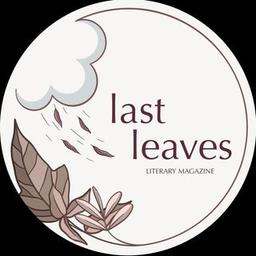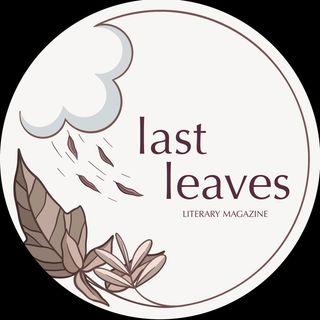Let’s kick this off with an obligatory one. What inspired you to start Last Leaves? It’s origin story, let’s say.
We talked a lot about starting a lit mag while we were in college. I can’t fully explain what the draw was. I (Cailey) was on the editorial team of the campus magazine, Willard and Maple, and I loved it. In college I also started to get my own work published, and the thrill of publication was so exhilarating. We wanted to be able to share that excitement and pride, and we wanted an excuse to be able to read a lot of poems. We did try starting a magazine while in college, but never got it off the ground. Then, a few years out of school when we were starting to become a little more established and confident (and had a little bit of money for the official investment) we got together again and made the dream happen.
As always, we like to ask journals to sum up their vibe in six words or less. What would they be?
Community, celebration, inclusivity, invitation, vulnerability, quirkiness
Your ‘about’ is super encouraging—where some journals wax on about themselves, you come with encouragement to submit right out of the gate. Is there a reason for this? The indie lit publishing scene can come off as daunting to newcomers. Did you intend to tackle this or just a personal choice?
This was absolutely intentional! We all went into the creation of Last Leaves with varying degrees of experience with poetry and submissions. As mentioned previously, Cailey had experience editing, submitting, and publishing. Kiera also had a lot of experience submitting her work, and she brought a lot of publishing and design knowledge into the group. Maina was somewhat dragged into the poetry world kicking and screaming by Cailey and Kiera. Coming from a prose and world building background, she didn’t have a lot of interest in writing or publishing poetry until later on in college.So, that being said, we wanted a magazine that fit all of those levels of interest. We wanted something accessible to writers who are terrified to submit or to writers who are just trying to fight through some writer’s block or writers who are seasoned submitters. The literary world can be so unbelievably pretentious and full of gatekeepers–we did not want to be that. We wanted to see work that wasn’t from one of the five white men we studied in high school, so we figured we’d make a space for it.
These days, there seems to be a split among journals to either release works as ‘posts’ or compile them into issues. What made Last Leaves choose the latter?
Honestly we never even considered separate posts. I think we always wanted to have a print magazine, so even though our first two issues were digital, we were always planning ahead to when we could offer print copies. That’s also why our issues end up being pretty long, we wanted a book that was worth buying and putting on your shelf and showing off to your friends.
Could you break down the process for curious writers on what goes into an issue? Let’s start from: you sit down and decide on the theme for the next issue of Last Leaves. From there, to holding it in your hand, what is the process? (Feel free to use your most recent issue as an example).
We get all submissions by email for two months at a time. Basically, we all three read every submission on our own. We’ll vote yes or no on each piece. Then, we meet once a week and discuss the poems. If we were split on a vote, we’ll discuss the piece together and decide as a group whether or not a poem makes it into the issue. Sometimes it’s really easy for one of us to convince the others, sometimes it’s a long conversation. Occasionally we have to leave a piece sitting for another week and come back to it with fresh eyes.I’m not sure how our process compares to other magazines, but we love it. We’ve often found that a poem we initially voted no on ends up being an absolute yes when we read it a second time or hear how another editor interpreted it. I love that this process allows us to read most poems multiple times and really look at it from another angle.After we make a decision, we email the poet or artist, compiled all the accepted poems, and then the incredible Kiera orders the poems and does all the design work so it’s ready to be read.
How do you decide the order of the poems in each issue?
Every issue is a little bit different. A lot of times before we’ve even read all the submissions a poem will stand out as the obvious candidate for first or last poem in the issue. We love when that happens. Other times we’ve met at the end of the submission window to talk about an order. Sometimes Kiera will notice a theme or group of themes as she’s working on the layout.For example, in Issue 5 Kiera noticed that many of the poems fit with specific seasons. So she organized the poems as if moving through the seasons in a year. Every piece fit in so nicely, and we were so proud of the order for this issue especially.
For the printed copies of each issue, what are some of the challenges of getting it printed and distributed? I imagine there is a sales element to it—finding shops to shelve it, sending it out to subscribers. What sorts of challenges have you faced in this vein and how’d you get around them?
We always wanted a print version of the magazine, but that definitely comes with a challenge. For us, holding your published poetry is just a really special feeling, and we wanted our contributors to have that feeling.We didn’t love the idea of supporting Amazon, so we were pretty excited to find out that Barnes and Nobles Press would allow us to publish the issues for a pretty low cost. However, the biggest difficulty is that Barnes and Noble doesn’t ship internationally. We have a lot of international contributors and we’re definitely frustrated that we can’t easily and affordably offer print copies to them.In terms of the sales element, we mostly set up print copies for our contributors. We wanted them to have the option of a print version. And we wanted to have physical copies we could hold and show off as well. We’re not really doing it to make any money ourselves (though it was an absolutely amazing moment when we were able to pay for our website’s domain using money we earned from selling issues!).
What is the most common mistake people make when submitting to Last Leaves that prospective writers should watch out for? Is there a particular irksome habit that results in an immediate ‘ick, no’ or more of just finding the poems that jive with your vision?
In short, not reading our website before submitting. We don’t expect contributors to read every past issue or anything. But when writers don’t follow basic guidelines we’ve gotten to the point where we have to send an instant rejection. Our guidelines are there for a reason, please follow them!Along the same lines, sometimes we get submissions that just do not fit the vibe at all. We’ve had submissions address us as “Dear Sirs” which shows that they didn’t even bother to click on our masthead and see that we are not men. Plus, if you read through our issues you’ll see that we do tend to like poems from marginalized and multicultural peoples. When we get submissions that feel exclusionary, cruel, or conceited we are likely to reject pretty quickly.Oh, also, we accept simultaneous submissions and we get that mistakes happen, but it’s really hurtful and frustrating when someone withdraws a poem after we accept it. If you do submit to multiple mags, be on top of your submissions and withdraw as soon as you get an acceptance so you don’t waste the editors’ time.
There seems to be this ongoing dialog about whether lit journals are dying, whether anyone reads them, why does anyone bother anyway? And yet, Last Leaves was founded in 2020. Not only that—from our database we can see that thousands of journals have been started in the past 5 years (nearly half). Why do you think, in an industry many debate is dying or little used, editors like yourselves keep creating spaces for writers?
2020 happened to be the golden spot. We always had plans to start a lit mag, it was just a matter of timing afterward. 2020 was the year that things slowed down enough for us to finally get started, and it was when we started craving community the most. All three of us were far from each other and we wanted to come back to the writing community that we held so dear.In our experience, lit mags aren’t dying. We get a lot of submissions and a lot of people who tell us they read through the entire issue. People call our poems they loved in previous issues when they submit to us. Contributors share their work. From our perspective, there is still space for art and poetry and creativity, and the world so desperately needs these things.
Is there any question you’d like to add to this interview that we didn’t cover? Feel free to drop it here and let us know how you would’ve answered it.
What’s one thing you wish you could tell every contributor? We have jobs and lives outside of editing Last Leaves, so it’s hard to make time for everything involved in the magazine. For that reason, our responses to contributors are usually pretty short and standard. However, we would love to be able to offer hand-picked feedback and encouragement to every writer. Seriously. We love reading your cover letters and hearing a little about your story, and we so wish that we could have a cup of tea or coffee and discuss poetry with every one of you amazing writers who submits. Thank you so much for believing in Last Leaves and sharing your work with us!
View Last Leaves Magazine on Chill Subs

